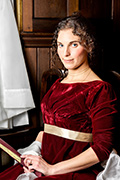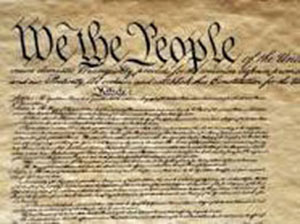Dolley Madison
Vivacious "Founding Mother"

Dorothy "Dolley" Payne Todd Madison, born to Quaker parents in 1768, came to live in Philadelphia when she was 15. There Dolley met and married John Todd. Eleven months after John and their infant son, William, died of yellow fever, she married Congressman James Madison.
For the remainder of the fourth session of Congress, the Madisons rented a large home in Philadelphia to accommodate themselves, Dolley's toddler son, John Payne Todd, and her sister Anna. When the Madisons returned to Montpelier after that Session, Dolley corresponded with her friends and family in Philadelphia, keeping each other up on the happenings of the day.
In 1801, their friend, President Thomas Jefferson, appointed to James as Secretary of State, and the Madisons moved to Washington. Here Dolley often found herself attending various dinners and other functions in support of her husband. In addition, she hosted “levees” (also call “squeezes”) and various other social functions in her homes. Along with other Cabinet wives, Dolley was called upon to act as hostess at state dinners that included wives when President Jefferson’s daughters were absent.
Later, as first lady, Dolley was an engaging hostess and established weekly parlors for the wives of officials. Due to the often political nature of the discussions, the phrases “petticoat politics” and “parlor politics” were applied to the apparent outcome of the discussions that occurred during these parlors.
Many legends have grown around Dolley, some that started during her lifetime. The most popular, and most difficult to contradict involves the Gilbert Stuart portrait of Georoge Washington. This is because there are some elements of fact buried in the legend.
What is fact is that when President Madison rode out towards Baltimore in August 1814, he left Dolley in charge of the White House with instructions to preserve state papers from destruction should the British march on Washington. She was to be ready to leave, with the household, the state papers and such articles of value as she could remove.
When the word came from James to evacuate, Dolley did just that. As she departed she realized Washington's portrait still hung in its frame - securely screwed to the wall. Lacking time to take it down properly she had the frame and stretcher broken so the painting itself could be removed, rolled and secured for safekeeping.
She also discovered the Declaration of Independence had not been removed from its glass case and secured with the other state papers. In this case, Dolley herself broke the case and removed the document to safety. Although household members helping her felt she risked her own safety seeing to removing these two items, she was able to depart Washington City entirely with her precious cargo and household with little time to spare before the arrival of the British troops.
After the inauguration of James Monroe as fifth president, the Madisons retired to Monpelier once again. After James died, Dolley returned to Washington City to once again be a popular and gracious hostess until her own death.
It is with great delight Mr. Madison and Mr. Jenks introduce not one, but two, ladies who bring Mrs. Madison's charm to life in the 21st century. It is unlikely that the ladies will be seen together with Mr. Madison, however, the insights and talents of Ms. Elissa Paulisson and Ms. Judith Kalaora allow them to share a dynamic view of Mrs. Madison with those who meet either of them in company with Mr. Madison and separately.

Elissa Paulisson
Elissa and her husband recently moved to Washington City (Washington, DC), and she is gradually re-entering the world of musical theater after taking a hiatus from an extensive performance schedule. She is an accomplished operatic soprano.

Judith Kalaora
Judith is a professional educator, actress, and historical interpreter. She graduated Magna cum Laude from Syracuse University and holds a Bachelor of Fine Arts in Acting, along with a Bachelor of Arts in Spanish Language and Culture. She completed the Globe Education Program of Shakespeare's Globe Theatre in London, England. Judith founded History At Play(TM) in 2010 to provide educational entertainment, chronicling the lives of influential and oft forgotten women. Judith researches, writes, produces, and performs the programs.
Learn more about Judith's one-woman shows at her website.

